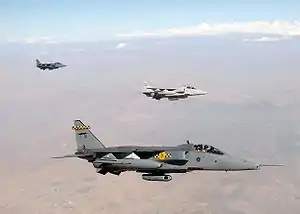Operation Northern Watch
Operation Northern Watch (ONW), the successor to Operation Provide Comfort, was a Combined Task Force (CTF) charged with enforcing its own no-fly zone above the 36th parallel in Iraq. Its mission began on 1 January 1997.
| Operation Northern Watch | |||||||
|---|---|---|---|---|---|---|---|
| Part of the Iraqi no-fly zones | |||||||
 Three British RAF Jaguars on a Northern Watch mission in September 2002. | |||||||
| |||||||
| Belligerents | |||||||
|
|
| ||||||
| Commanders and leaders | |||||||
|
|
| ||||||
| Strength | |||||||
| Around 50 aircraft and 1,400 personnel at any one time[3] | Various Iraqi air defense forces | ||||||
| Casualties and losses | |||||||
| One F-16 damaged | 5–10 Killed, 30–40 wounded, 4 air defense systems destroyed | ||||||
The coalition partners of the United States, United Kingdom, and Turkey provided approximately 45 aircraft[4] and more than 1,400 personnel to support Operation Northern Watch. The joint U.S. forces of some 1,100 U.S. personnel, included airmen, sailors, soldiers, and Marines, as well as aircraft from every arm of the United States Armed Forces.
The original mandate from the Turkish government allowed the operation to continue for six months. Turkey subsequently approved two 6-month extensions, but indicated that it would not become a permanent mission.
For the first year of the mission, northern Iraq was quiet, with no combat between Coalition aircraft and Iraqi forces.
Operation Northern Watch forces did not take part in Operation Desert Fox in December 1998. After Desert Fox, Iraq announced they would no longer recognize the no-fly zones and urged their troops to attack Coalition aircraft. On 28 December 1998 Iraq fired SA-3 surface to air missiles against coalition aircraft patrolling the northern no-fly zone. In response, U.S. Air Force (USAF) F-15Es, F-16CJs, and U.S. Marine Corps (USMC) EA-6Bs launched anti-radiation missiles and dropped precision guided munitions (PGMs) on the SA-3 ground-based missile site that fired on the ONW aircraft, and destroyed it.[5] From December 1998 to March 1999, U.S. aircraft over northern Iraq came under almost daily fire from Iraqi surface-to-air missile sites and anti-aircraft guns. U.S. aircraft responded by bombing Iraqi air-defense sites, using laser-guided bombs as well as AGM-88 HARM missiles and AGM-130 long range air-to-surface missiles.[6] The first combat use of the AGM-130 was conducted during ONW.
Coalition aircraft flew patrols on an average of 18 days per month, and were usually fired upon. The most common threat was from anti-aircraft guns. Despite Saddam Hussein offering a $14,000 reward for downing a Coalition aircraft, no warplanes were shot down.[7]
Low level conflict continued up until the invasion of Iraq in 2003, although the number of response incidents declined dramatically after 1999. The final combat air patrol occurred on 17 March 2003 (from the Incirlik Air Base). Six weeks later the operation concluded with an official stand down on 1 May 2003.
A grand total of 36,000 sorties were flown during Operation Northern Watch, and 40,000 personnel had been deployed at some point during the operation.[7] Operation Northern Watch was the longest combat operation in the history of the European Command.[5]
See also
References
- http://www.stripes.com/01/jun01/ed060401a.html%5B%5D
- Defense.gov News Article: Patrolling Iraq's Northern Skies
- Operation Northern Watch | Globalsecurity.org
- http://www.1stfighter.org/F15s/images_f15s/onw.jpg
- Transcript from 16 Nov 1999 briefing of Brig Gen David A. Deptula, commander ONW 1998, 1999 at the Aerospace Power Seminar series, Washington, D.C.
- "Operation Northern Watch: 1999 Events". GlobalSecurity.org. Retrieved 22 February 2016.
- Operation Northern Watch